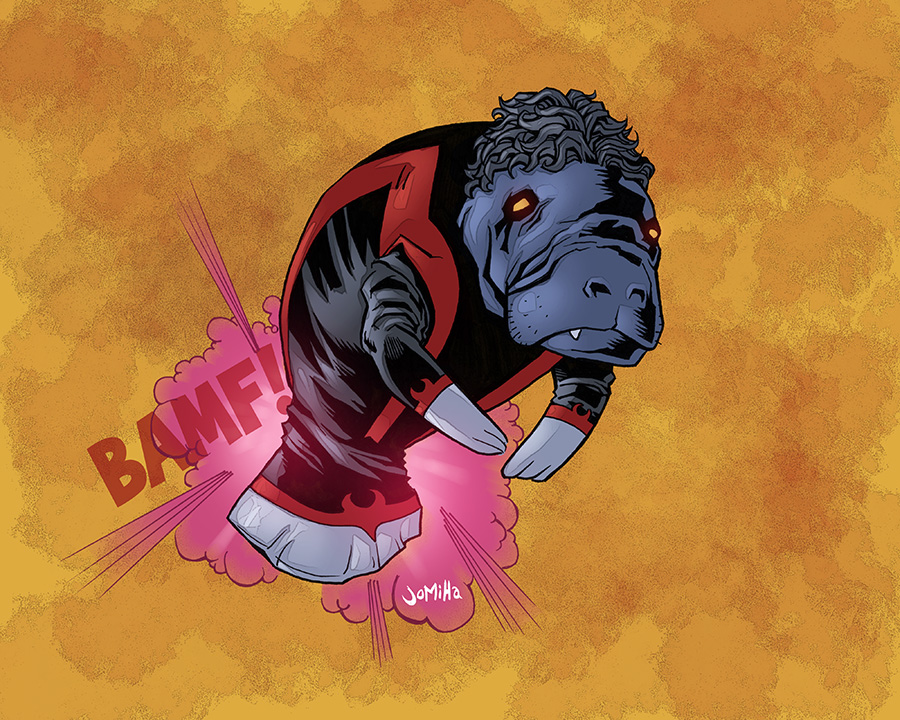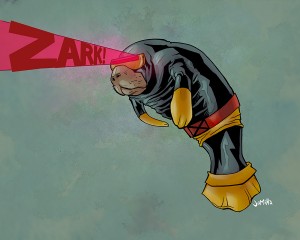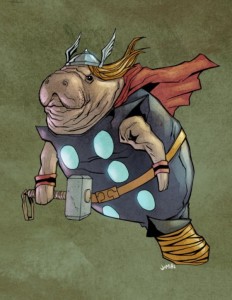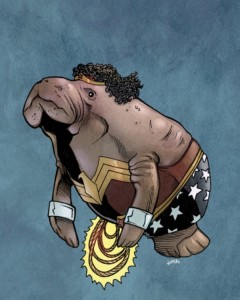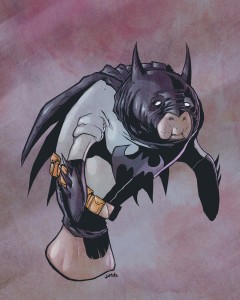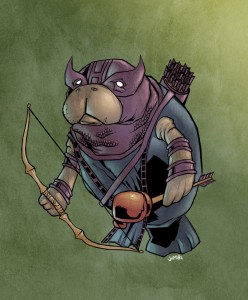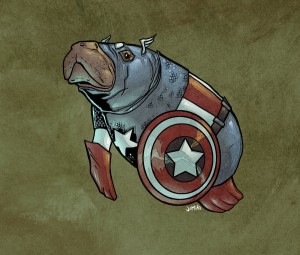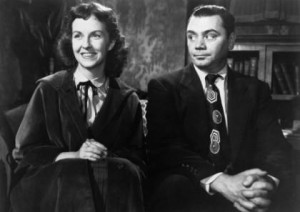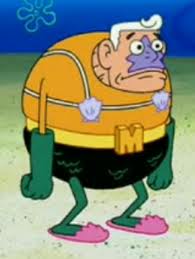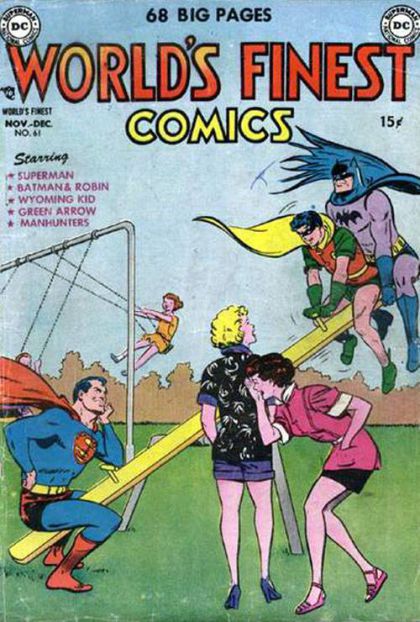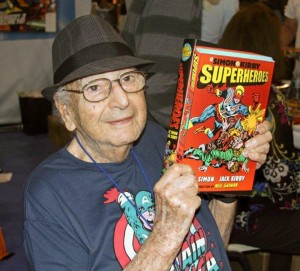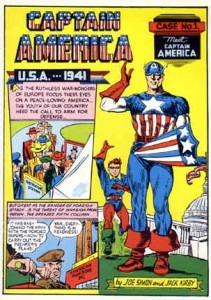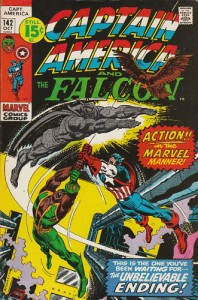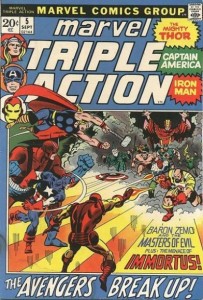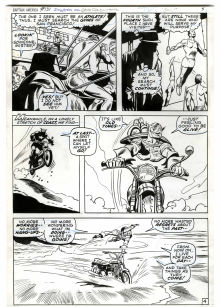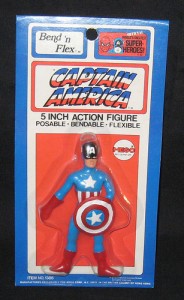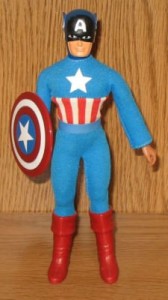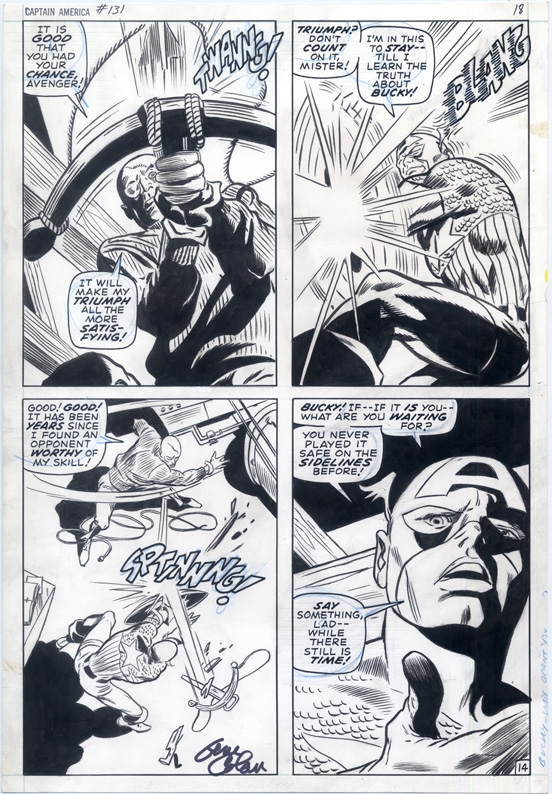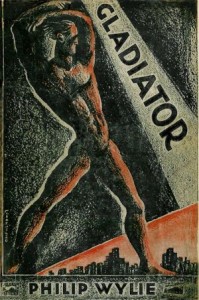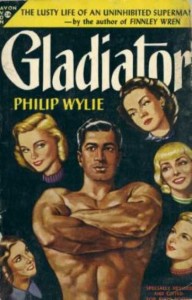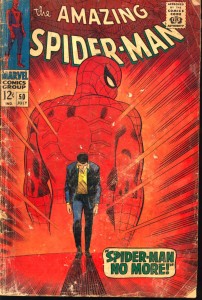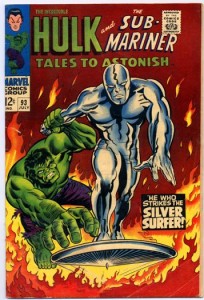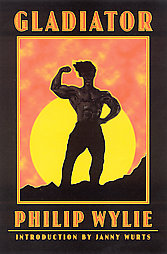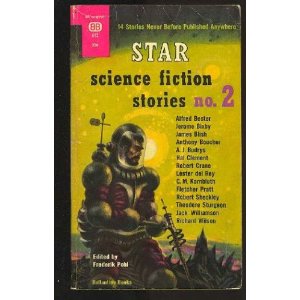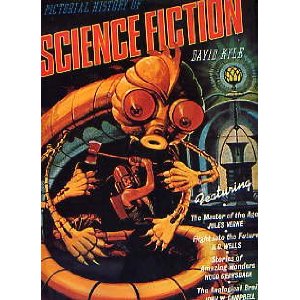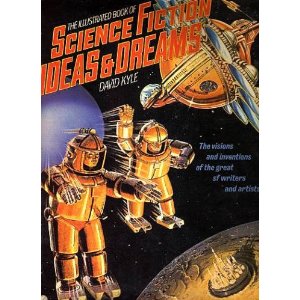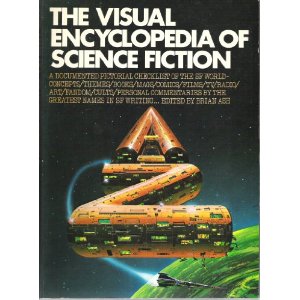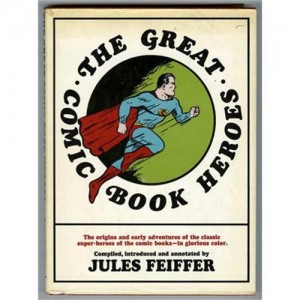
My gateway to the heroes of comics' Golden Age, courtesy of my stepdad and Jules Feiffer
Any culture that fails to train its young in its traditions is doomed to extinction. The culture of science fiction geekdom is no exception. Many SF geeks have come into their geekhood entirely on their own, sometimes in clear opposition to their parents’ preferences (most of the Futurians, for example, needed to get away from their families in order to come into their full geekhood). Yet many others (myself included) have benefitted from the support and encouragement of a geek (or partial geek, or proto-geek) parent. SF geek culture has now been with us long enough that grandparents can share it with their grandchildren (especially if it is Flash Gordon serials or Astounding Science Fiction pulps or EC horror comics that are the artifacts being passed on).
My stepdad was my initial mentor in geekdom, although I’m sure he didn’t think about in those terms (my training in geekhood began in the late 1960s, but the term “geek” did not begin taking on anything approaching a positive connotation until fairly recently, sometime during Bill Clinton’s term in office). He is a movie lover and for many years was an amateur movie maker (in the old days of Super-8 equipment; he never made the transition to digital media). During his twenties, he had nursed an ambition to go to Hollywood to work for Warner Brothers as an animator. He ended up a salesman instead, a very successful one, first of shoes and later of folding cardboard boxes. He and my mother both enjoyed science fiction and horror movies, so my earliest movie-going experiences were outings to the drive-in to see pictures including Destroy All Monsters (1968), The Return of Count Yorga (1971), Escape From the Planet of the Apes (1971), and Godzilla vs. the Smog Monster (1971). (Come to think of it, we saw an awful lot of movies at the drive-in in 1971.) He was a huge fan of old-time film actors, so the bookshelf in our living room was stocked with oversized volumes on the history of movies serials, classic films of Hollywood’s Golden Age (including the Universal monster movie cycle), and silent film comedy stars such as Charlie Chaplin and W. C. Fields. He also amassed a pretty big collection of Super-8 film shorts to show on his collapsible movie screen, including shorts by Chaplin, the Our Gang kids, and Laurel and Hardy, as well as compilations of coming attractions from Japanese kaiju giant monster films and 1950s Hollywood giant insect movies.
The book on his shelf that probably had the biggest impact on me, though, was Jules Feiffer’s The Great Comic Book Heroes (1965). I still have numerous passages virtually memorized (most especially Feiffer’s remembered glee as a young man when he read that psychologist Fredric Wertham had written in Seduction of the Innocent that Batman and Robin, in their civilian identities as Bruce Wayne and his ward Dick Grayson, could be said to be experiencing “a wish dream of two homosexuals living together;” Feiffer always hated Robin, so anyone who muddied Robin’s rep was okay by him). I passed hundreds of hours on my living room sofa with that book open on my lap. Feiffer presented a very personal memoir of what each of the classic characters of the Golden Age of Comic Books had meant to him during his childhood and teen years. His book generously provided me with origin stories or very early adventures of such figures as Superman, Batman, the Flash, the Green Lantern, Wonder Woman, Hawkman, the Spectre, Plastic Man, Captain Marvel, Captain America, the Sub-Mariner, the Human Torch, and the Spirit, in nearly all cases (with the exceptions of Superman and Batman) my very first exposure to the characters. My stepdad, noting my enthusiasm, followed up by taking me to my very first comic book and nostalgia convention, held in the Coconut Grove library, where I got to see a couple of chapters from Monogram’s The Adventures of Captain Marvel serial and page through a mimeographed reproduction of the famous Human Torch-Sub-Mariner epic battle from Marvel Mystery Comics.
The fact that my stepdad loved old monster movies and old comic book heroes made me want to love them, too; not that I needed too much encouragement in that direction, since I had discovered my love of dinosaurs, prehistoric life, and Greek and Norse mythology all on my own. One thing led to another. Novelizations of the Planet of the Apes films and TV shows proved to be my “entry drugs” to original science fiction novels and story collections by H. G. Wells, Ray Bradbury, Isaac Asimov, and Robert Silverberg. A fondness for atomic apocalypse movies led to my picking up books on worldwide catastrophe by J. G. Ballard and John Christopher. The movie versions of The Shrinking Man and I Am Legend made me hunt down the original books by Richard Matheson. The same kid at summer camp who let me look at his dog-earred Iron Man comics also lent me a truly magical novel, The Circus of Dr. Lao by Charles G. Finney.
And thus was my career as a science fiction geek well and truly launched by the time I turned eight. That year I wrote my first short story, “Tyrann!”, a tale about a lonely little boy, his scientist father, the mechanical Tyrannosaurus the father builds as a companion for his son, and the gangsters who have evil plans for the scientist and his robot creation. The boys at school loved it, and I got the idea that writing stories and entertaining my peers was kind of fun.
One thing my stepdad didn’t do was pass on any relics of his own proto-geek childhood. Hardly anybody from his generation saved their comic books and pulp magazines (unless they were extremely obsessed with them). This, of course, is what makes those artifacts of the 1930s and 1940s so valuable – scarcity. Oh, the daydreams I had, though, as a child – “If only Dad had saved his Captain America comics!” I resolved at a very young age that I would save everything: all my comics, all my issues of Famous Monsters of Filmland, all my copies of Eerie and Creepy, and all of my science fiction paperbacks. No future son (or daughter) of mine would ever have to pine for the childhood stuff I had thrown away. I also considered the potential monetary value of the collectibles I would be passing on, figuring I would be doing my future children a great fiduciary favor.
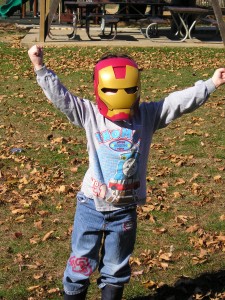
Judah "Iron Man" Fox, celebrating his fifth birthday
Unfortunately, I proved to have an odd talent for buying comics which would never go up in value and for passing up those comics which would someday be worth real money. I distinctly recall seeing all the early issues of The All-New, All-Different X-Men on the carousel wire racks at my local convenience stores (Little General and 7-11) and turning up my nose at them, because the characters on the covers looked “too weird” (why I felt that way about the New X-Men I cannot currently fathom; after all, I eagerly purchased other comics with stranger heroes, such as Jack Kirby’s The Demon and Marv Wolfman’s The Tomb of Dracula, but I remember having a powerful aversion to the costumes worn by the New X-Men in their early adventures). Instead, I bought reprint comics like Marvel Triple Action, Marvel’s Greatest Comics, Monsters on the Prowl, and Creatures on the Loose; the adventures of short-run, failed characters like It! the Living Colossus, the Living Mummy, Man-Thing, Brother Voodoo, the Defenders (a bit more successful than the others on this list), the Invaders, the Golem, and Werewolf by Night; and a fairly full set of The Invincible Iron Man during the character’s worst run ever (excepting, perhaps, the much later Teen Tony issues), from about issue 35 to issue 90 or so. So I ended up with an accumulation of essentially worthless comics, boxes and boxes of them, from the 1970s to the 1990s. Worthless, that is, except for the reading pleasure they might provide a young person.
Over the past eight years, I’ve been blessed with three sons. How should I divide my childhood collection among the three of them, I’ve often wondered? Have them draw lots? Let them sort out the materials among themselves, according to their preferences, with me serving as referee? As things have turned out, this will not be an issue, surprisingly; two of the three appear to have very little interest in my old stuff.
Levi, my oldest, is a voracious reader, but he generally avoids comic books. He showed a mild interest in Silver Age Superman stories for a time, but that didn’t last. After I took him and his brothers to see Captain America: the First Avenger, we went to the comic book store next to the theater, and I offered to buy him any Captain America or Avengers comic he wanted. He wouldn’t bite; instead, he insisted I buy him the latest Wimpy Kid chapter book. The only comics or graphic novels he seems to be interested in are the Bone books. He is very interested in science, but blasé about dinosaurs. He shows very little interest in my collection of old horror movie videos. However, he is fascinated by astronomy and outer space, and most of the chapter books he likes to read (such as the Magic Treehouse and the Captain Underpants books) are essentially fantasy. So I have hopes that I’ll be able to steer him toward science fiction. Within the next year (he is currently in second grade) I plan to introduce him to the Heinlein juveniles, the Rick Riordan books, and eventually Ender’s Game. We’ll see how he takes to those. He is very opinionated and particular regarding what books he chooses to read, so I know I will only be able to suggest (and gently suggest, at that). The potential for an SF geek resides within him (“The Force is strong in this one…”). We shall see.
Asher, my middle child, on the other hand, appears to have little or no geek potential. His interests are decidedly mainstream American boy – he likes sports, race cars, and monster trucks. He enjoys superhero and science fiction movies and TV shows, but he mainly appreciates them for their action. He likes watching things explode and seeing giant robots beat on each other. He thought the last twenty minutes of X-Men: First Class were “awesome,” and he simply loved Real Steel. His favorite toys are his large collection of Hot Wheels cars. He is a pretty strong reader, but he won’t go out of his way to pick up a book. He gets bored when I try to read him Silver Age Superman stories (which Levi enjoys to an extent). His preferred books to look at are illustrated editions of The Guinness Book of World Records and any books on monster trucks.
So, I was at two strikes and one ball to go, so far as passing along my old comics and monster magazines to one of my offspring. Perhaps Judah, my youngest, sensed an opportunity, an unclaimed niche, a chance to beat out his brothers at snuggling up close to Daddy. Or maybe it’s all in the genes (could there be a specific geek chromosome)? In any case, with my final opportunity to reproduce myself as a young geek, I finally struck geek gold in Judah. Several years back, I bought a whole collection of plush Godzilla figures for Levi and Asher as Hanukkah gifts; on eBay, I found Godzilla, Minya, Rodan, Anguillis, Gigan, young Godzilla, Hedorah, King Kong, and Destroyah. These were gorgeous toys. Had they been available when I was a young boy, I would have wet my pants with excitement. But neither Levi nor Asher took to them. They sat on the edge of the boys’ bed for years, unplayed with, gathering dust and cat hair.

Judah with "The Deadly Mantis"
Then Judah decided he liked Godzilla movies. In fact, he loved Godzilla movies. Better still was to watch a Godzilla movie with toys that matched the monsters on screen. He expanded his palate to include a fondness for Gamera movies, too (and I happened to have a few Gamera toys lying around). He will watch any monster movie with his daddy, and he has a particular liking for giant insect movies. Like me, he can watch Tarantula over and over again. When I took him and his brothers to Dinosaur Land in White Post, Virginia, one of the statues there was of a ten-foot-tall praying mantis. I took a picture of the boys standing beneath its claws, and I posted the picture on my website, next to a photo from the 1957 monster movie The Deadly Mantis. Judah took a look at that photo and declared he simply had to have a Deadly Mantis toy. After looking far and wide, I managed to find a really nice praying mantis figurine at Le Jouet Toys down in New Orleans, and I bought it as a birthday gift for Judah. One event marking his fifth birthday celebration was a family viewing of The Deadly Mantis (a clean DVD print obtained from Netflix). Judah sat in bed between me and his brothers with his brand-new mantis toy in his fist, watching Craig Stevens, William Hopper, and Alix Talton deal with their bug problem. He is very disappointed that there has never been a Tarantula vs. the Deadly Mantis movie, or, even better, a Tarantula vs. Godzilla film. He has asked multiple times for me to buy him a Deadly Mantis costume to wear, and I’ve endeavored to explain that no one is likely to make a costume based on a giant bug movie from 1957 that hardly anyone remembers.
It’s not just monsters. He loves dinosaurs and superheroes, too. His favorite dinosaur (for the past few weeks, anyway) is Ankylosaurus, an armored dinosaur from the Cretaceous Period. When I told him that Anguillus from the Godzilla movies is an Ankylosaurus, he went and got his plastic figurine of the monster and asked why Anguillus doesn’t have a knob of bone at the end of his tail like a real Ankylosaurus would. The only reply I could come up with was “artistic license.” So he went and found a small, hollow rubber ball that he was able to insert on the end of Anguillus’ tail. Thus far, he doesn’t seem to have a favorite superhero. Between his dad’s old toys and action figures he has gotten as gifts or collected from McDonald’s or Burger King, he has amassed a pretty impressive set of Justice Society, Justice League, X-Men, and Avengers figures. His affection and loyalty shifts between characters and figures, depending on his mood and which toy happens to catch his eye. One day his favorite will be Banshee from the X-Men, and the next day it might be Captain America or Iron Man, and the day after that either Batman or the Golden Age Flash will have captured his fancy.
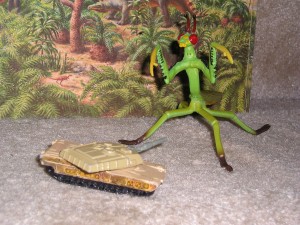
Scene from "The Deadly Mantis 2: Mantis in Manassas"
He’s still too young to pass along to him my old comics and issues of Famous Monsters of Filmland (I shudder to think what shape he would leave them in after tearing through them). I’ll probably wait until he turns eight. But that kid has a tremendous bequest coming his way. I can hardly wait to see his face on the day I pull out box after box after box of my old stuff from the basement.
For the time being, I’m as delighted as any proud Little League parent to have him sitting next to me and watching Ghidrah the Three Headed Monster or Tarantula, a rapt look of enjoyment on his face. I glance down at him, squirming with excitement while nestled in the nook of my arm, and think to myself with a glow of satisfaction, “That’s my boy!”
Like this:
Like Loading...

